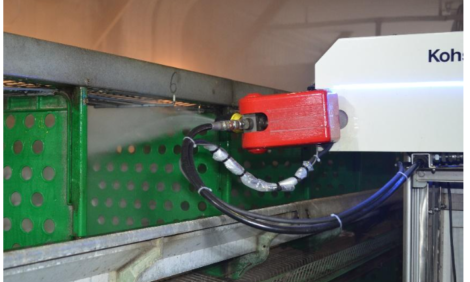



Counteracting Trichothecenes in Animal Feed
In feeds and feed ingredients, poorly adsorbable mycotoxins like trichothecenes need to be counteracted by biotransformation, says Karin Naehrer of Biomin.Infection of agricultural commodities by different fungal species is of increasing concern as mycotoxins may be produced. These toxic metabolites can cause acute or chronic intoxication when ingested by higher animals, resulting in an economic impact in the industry. Of special interest are Fusarium mycotoxins, which mainly infect plants on the field but growth and mycotoxins production can continue during storage.
Fungal colonisation and growth and/or mycotoxin production are influenced by a variety of factors but the most important are temperature and water activity, i.e. available water content to a mould in a substrate. The largest group of mycotoxins comprises the trichothecenes (type A e.g. T-2 toxin and type B e.g. deoxynivalenol), which can contaminate commodities like corn, wheat, barley and oats.
The most abundant source of trichothecenes contamination in cereal grains today is due to Fusarium head blight, which is primarily caused by type-B trichothecene-producers (Foroud and Eudes, 2009). A survey of the occurrence of mycotoxins in agricultural in commodities, feeds and feed ingredients sourced in the Middle East and Africa was performed. In South Africa, B-trichothecenes were the main contaminant, with 87 per cent of samples tested positive at a mean contamination level of 1469µg per kg (Rodrigues et al., 2011).
Toxicity
Trichothecenes are potent inhibitors of eukaryotic protein synthesis; different trichothecenes interfere with initiation, elongation and termination stages (Bennett and Klich, 2003).
Experimental studies with animals exposed to a low dose of trichothecenes result in vomiting, diarrhoea, gastroenteritis and immune dysfunction, whereas higher doses cause severe damage to the lymphoid and epithelial cells of the gastrointestinal mucosa resulting in haemorrhage, endotoxaemia and shock (Pestka 2010). The most common effects of prolonged dietary exposure of experimental animals to deoxynivalenol are feed refusal, decreased weight gain, vomiting, decreased nutritional efficiency and altered immune function with species differences again being apparent (EFSA, 2004; Pestka, 2007).
The effects of Fusarium mycotoxins, deoxynivalenol (DON) and zearalenone (ZON) on growth performance, blood chemistry, immune response and the alleviating effect of Mycofix® Plus (MPL) were investigated on 48 weaning piglets (Cheng et al., 2006). Only 49 per cent of the chemotactic activity was found in the DON- and ZON-challenged group in comparison to the control group. The addition of Mycofix Plus (0.15 per cent) improved the ability of chemotaxis and phagocytosis to a level similar to the control group (Table 1).
| Table 1. The effects of DON and ZON on alveolar macrophage activities in pigs | ||||
| Groups | Control group | 1ppm DON, 250ppb ZON | 1ppm DON 250ppb ZON, 1.5kg/ton MPL | 1.5kg/ton MPL |
|---|---|---|---|---|
| Chemotactic Index % of phagocytic macrophages |
4.24a 27.6a |
2.07b 20.8ab |
4.42a 25.6ab |
4.20a 25.2ab |
| a,b Different superscripts indicate significant differences (P<0.05) | ||||
Counteraction
Contamination of agricultural products with mycotoxins occurs despite the most strenuous efforts of prevention. Adsorbent agents (binders) may be added to the feed and bind mycotoxins during digestion in the gastrointestinal tract resulting in a reduction of toxin bioavailability. Mycotoxins vary in their structure therefore adsorption (simple binding by clay, mineral, yeast cell wall binders as commonly found in the market) offers only a very limited solution to the problem of mycotoxins (e.g. aflatoxins).
Other less or non-adsorbable mycotoxins like trichothecenes, e.g. deoxynivalenol, need to be counteracted by a different approach. Biotransformation stands for the conversion of mycotoxins into non-toxic metabolites by the action of enzymes or life microbes. It has been known for years that some microorganisms are able to degrade some mycotoxins. However, only certain microorganisms have the potential to degrade trichothecenes such as deoxynivalenol, ochratoxin A and zearalenone and meet the prerequisites for use as animal feed additives. Mycofix gathers adsorption, biotransformation and bioprotection (plant and algae extracts for immune- and hepato-protection) in one product – a complete tool for effective mycotoxin risk management!
April 2012









